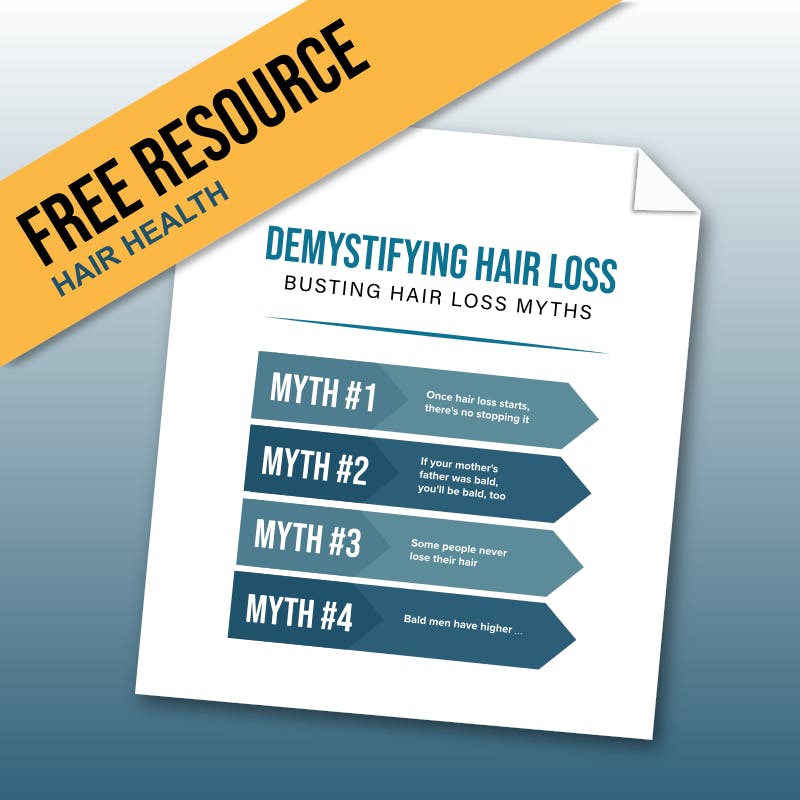Minoxidil Before and After
We show how minoxidil can help you fight hair loss in this set of before and after photos.

Minoxidil is a non-prescription hair loss treatment that you typically apply directly to your scalp. Exactly how it works is still a bit of a mystery, though many theories abound. What’s important is that research shows it to be safe and effective.1 Around two-thirds of men who use minoxidil in clinical studies see a cessation of hair loss followed by a period of regrowth that lasts for as long as they continue to apply the solution.2
But those results take some time. You’ll have to apply minoxidil consistently for several months before you see a significant difference. That’s why we’ve collected these images of hair loss patients who have had success using topical minoxidil, sometimes known by the brand name Rogaine. These before and after shots should give you a rough idea of what minoxidil can do for you.
Of course, your experience won’t mirror anyone else’s exactly. Everyone’s response time to minoxidil is different. Still, seeing the treatment’s potential should give you the hope and drive you need to apply it twice daily.
If you’re curious about minoxidil or other hair loss solutions, you should check out our guide to the best hair loss treatment.
What to notice in minoxidil before and after photos
Minoxidil works best for growth at the crown and vertex of the scalp. It isn’t ideal for regrowth at the hairline.2 You’ll want to pay close attention to those areas at the top of the head where thinning hair will appear fuller after a lengthy minoxidil regimen. You may see less scalp through the hair and might even notice an increase in follicle density.
In the image below, notice that the hairline doesn’t necessarily move forward, but there’s a marked increase in health and density leading up to it. This is after six months of treatment.

That subtle change in growth allows the patient to have a more natural part location and for the style to hide any remaining recession. It looks more like his natural forehead shape and size rather than the appearance of someone struggling with hair loss. This process takes time, but here’s a look at what you might expect throughout your first 100 days:

There is very little difference in fullness until the image from day 73. It usually takes at least three months to start seeing new growth like this, so, if anything, this timeline is somewhat accelerated.
Let’s take a look at a large handful of minoxidil before and after photos for more context.
Minoxidil (topical) before and after 2-6 months
Top to bottom, the length of minoxidil treatment goes from shorter to longer (up to 6 months) in these before and after photos.





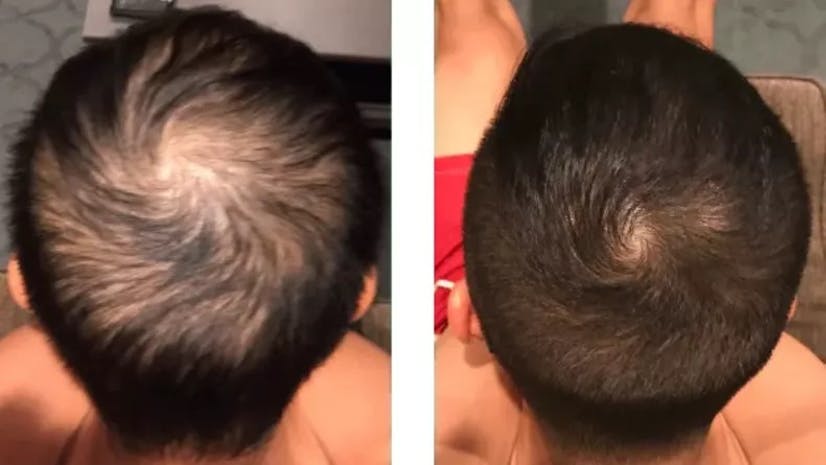

Our bottom line recommendations for minoxidil
It’s during that period of two to six months when many men become very encouraged by the improvements they see. As you’ll see in the images below, there are a few ways to use minoxidil as part of a hair loss treatment regimen.
- You can apply it as a topical serum, as shown in pictures above and below.
- You can take it as an off-label oral medication prescribed by a dermatologist. Keep scrolling to see before-and-after photos of oral minoxidil.
- Very commonly, topical minoxidil is combined with oral or topical finasteride. This often yields more dramatic effects than either medication alone.
As for where to most conveniently and affordably get your minoxidil, here are our recommendations:
- For topical minoxidil on its own, we typically recommend Keeps, which offers the best prices and a choice between minoxidil serum and minoxidil foam. Preferences vary when it comes to foam or serum, depending on grooming habits, hair length and/or style, and scalp sensitivity to the serum; some people also prefer to have both handy.
- For a combination of topical minoxidil and oral finasteride, you could get the former from Keeps and the latter from Roman to maximize your savings in the long term. That would also make it easier to access medication through Roman to address potential side effects associated with oral finasteride. But stick with Keeps if you want to get it all from one company or if you want the best deal over your first three months, during which you’ll get 50% off standard pricing.
- Hims is typically our top recommendation for a combined topical minoxidil and finasteride solution.
- For oral minoxidil, we recommend Roman over other providers for both pricing and available dose strength.
Let’s look at before and after photos across a longer span of time for topical minoxidil as well as the combination and oral treatment approaches.
Minoxidil (topical) before and after 7-12 months
Here, top-to-bottom, you can see before and after minoxidil photos as treatment progresses during the second half of a year of minoxidil treatment.




Combined oral finasteride and topical minoxidil: before and after
Studies into the efficacy of a combined approach — putting topical minoxidil and oral finasteride (Propecia) together — show impressive results.3 It seems that the drugs work well together, with no contraindications and significantly improved outcomes.
You can see before and after photos for finasteride here, but below are some images that show how well they can work together. Some of these images represent minoxidil combined with topical finasteride, while others represent minoxidil combined with oral finasteride.
Before and after: one year or less





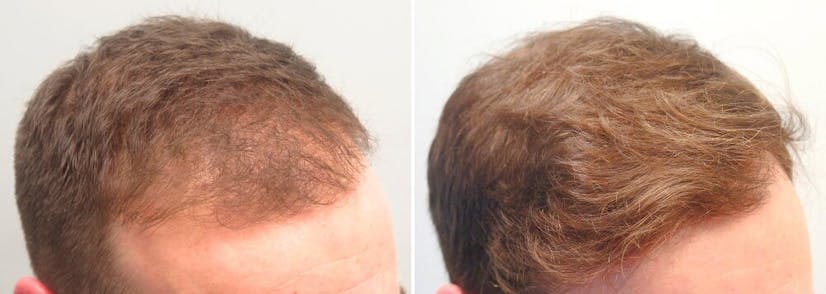
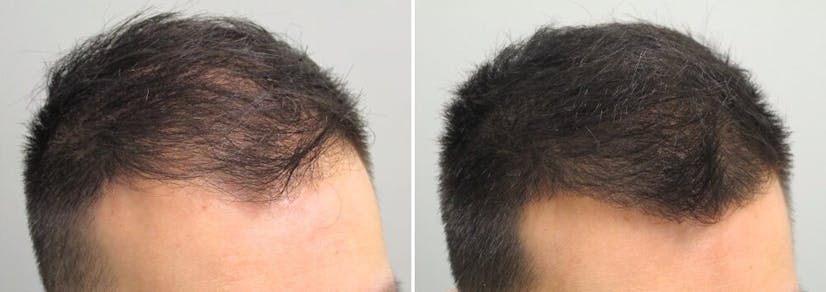


Before and after: more than a year
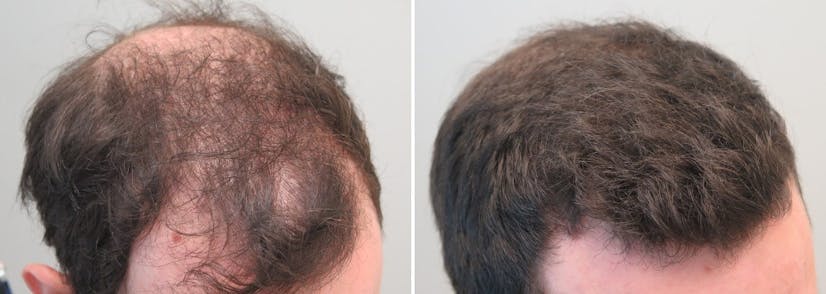







Studies have demonstrated that topical finasteride does work well in conjunction with minoxidil (as before and after photos also show), though the efficacy rates are not quite as stellar as oral finasteride with minoxidil. On the other hand, topical finasteride carries with it a significantly lower risk of side effects as you use it.4 Some men would prefer taking a pill rather than applying one more product on their scalp, though.
Oral minoxidil before and after
In recent years, oral minoxidil has become a viable tool for those seeking an oral medication for hair loss that doesn’t pose the same side effect risks as oral finasteride. Multiple studies have looked into its safety and efficacy, and it appears to work at least as well as the topical medication.10 There is a risk of hypertrichosis, which is unwanted hair growth on other body parts, but study participants typically stuck with the treatment even when extra growth occurred.11
Here are a few before and after pictures showing oral minoxidil in action. We’ll start with two patients who were part of a study from late 2020 evaluating oral minoxidil for hair loss.11 Each image shows the participants at baseline, 12 weeks, and 24 weeks from two angles.


And here’s a closeup view illustrating how oral minoxidil positively impacts follicle density after 24 weeks:

Oral minoxidil will prove to be a viable option for many — especially women, for whom finasteride is not suitable due to its impact on androgen hormones.
Oral minoxidil is not currently FDA-approved for hair loss, but it is FDA-approved to lower blood pressure.5 Dermatologists typically prescribe it off-label in cases of hair loss. You can get it from several online providers nowadays, and we think Roman is the best of them.
How does minoxidil work?
Minoxidil’s exact mechanism of action isn’t completely understood within the scientific community. There is evidence that it increases vasodilation in the scalp, which can deliver more nutrients to damaged follicles.6 It also appears to reset growth phases, which can combine with superior nutrient delivery to grow more hair that’s stronger and thicker. There also appear to be some various signaling pathways at play, as well as influence over stem cell designations.7 8
Whichever combination of mechanisms of action are at play, what is clear is that minoxidil works for a majority of users. Results take time, and they aren’t always very dramatic, but it’s a reliable way to stop hair loss in the least and regrow hair in many cases.2
Is minoxidil safe?
Minoxidil is very safe, especially in its topical formulation. The greatest risk you run is itching, burning, scaling, or other discomfort at the scalp.1 In a lot of cases, this is actually due to the use of propylene glycol in minoxidil serum, which is a known irritant.9 That’s why many people reach for minoxidil foam, which typically excludes propylene glycol and should have a lower risk of side effects as a result.
Oral minoxidil won’t present these symptoms, but it has a direct effect on blood pressure.5 If you’re dealing with both hair loss and hypertension, it may actually let you kill two birds with one pill. But a thorough evaluation of your heart health and cardiac history is a must if you intend to take oral minoxidil.
Alternatives to minoxidil
Minoxidil is an excellent choice if you’re opposed to prescription medication, but many studies show that a combination of minoxidil and prescription finasteride can provide immense benefits.3 However, there are alternatives to either of those options. They include hair restoration or replacement, laser therapy, nanoxidil, and more. To learn more about minoxidil’s cousin, nanoxidil, and what makes them different, check out our Nanoxidil vs Minoxidil guide.
If you’re curious about minoxidil or its viable alternatives, be sure to read our comprehensive Guide to the Best Hair Loss Treatments.
Final takeaway
Based on the research, it’s clear that minoxidil — both oral and topical — is likely to help most users stop hair loss and potentially even regrow hair. Hopefully the images we’ve collected and shared here provide some sense for how the results of your treatment would unfold, should you choose to try minoxidil. Results will require patience and consistency, but if you’re concerned about your progressing hair loss, it’s a great place to start treatment.
Sources
Innerbody uses only high-quality sources, including peer-reviewed studies, to support the facts within our articles. Read our editorial process to learn more about how we fact-check and keep our content accurate, reliable, and trustworthy.
Rietschel, R. L., & Duncan, S. H. (1987). Safety and efficacy of topical minoxidil in the management of androgenetic alopecia. Journal of the American Academy of Dermatology, 16(3 Pt 2), 677–685.
Suchonwanit, P., Thammarucha, S., & Leerunyakul, K. (2019). Minoxidil and its use in hair disorders: A review. Drug Design, Development and Therapy, 13, 2777-2786.
Hu, R., Xu, F., Sheng, Y., Qi, S., Han, Y., Miao, Y., Rui, W., & Yang, Q. (2015). Combined treatment with oral finasteride and topical minoxidil in male androgenetic alopecia: a randomized and comparative study in Chinese patients. Dermatologic Therapy, 28(5), 303–308.
Piraccini, B. M., Scarci, F., Jansat, J. M., Falqués, M., Otero, R., Tamarit, M. L., Galván, J., Tebbs, V., Massana, E., & Study Group, T. F. (2022). Efficacy and safety of topical finasteride spray solution for male androgenetic alopecia: A phase III, randomized, controlled clinical trial. Journal of the European Academy of Dermatology and Venereology, 36(2), 286-294.
Sica, D. A. (2004). Minoxidil: An Underused Vasodilator for Resistant or Severe Hypertension. The Journal of Clinical Hypertension, 6(5), 283-287.
Messenger, A. G., & Rundegren, J. (2004). Minoxidil: mechanisms of action on hair growth. The British Journal of Dermatology, 150(2), 186–194.
Choi, B. Y. (2020). Targeting Wnt/β-Catenin Pathway for Developing Therapies for Hair Loss. International Journal of Molecular Sciences, 21(14).
Choi, N., Shin, S., Song, S. U., & Sung, H. (2018). Minoxidil Promotes Hair Growth through Stimulation of Growth Factor Release from Adipose-Derived Stem Cells. International Journal of Molecular Sciences, 19(3).
Lessmann, H., Schnuch, A., Geier, J., & Uter, W. (2005). Skin-sensitizing and irritant properties of propylene glycol. Contact Dermatitis, 53(5), 247-259.
Ramírez-Marín, H. A., & Tosti, A. (2022). Role of Oral Minoxidil in Patterned Hair Loss. Indian Dermatology Online Journal, 13(6), 729-733.
Panchaprateep, R., & Lueangarun, S. (2020). Efficacy and Safety of Oral Minoxidil 5 mg Once Daily in the Treatment of Male Patients with Androgenetic Alopecia: An Open-Label and Global Photographic Assessment. Dermatology and Therapy, 10(6), 1345-1357.


